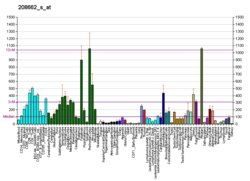| TTC3 |
|---|
|
| Identifiers |
|---|
| Aliases | TTC3, DCRR1, RNF105, TPRDIII, tetratricopeptide repeat domain 3 |
|---|
| External IDs | OMIM: 602259; MGI: 1276539; HomoloGene: 2487; GeneCards: TTC3; OMA:TTC3 - orthologs |
|---|
| Gene location (Human) |
|---|
 | | Chr. | Chromosome 21 (human)[1] |
|---|
| | Band | 21q22.13 | Start | 37,073,226 bp[1] |
|---|
| End | 37,203,112 bp[1] |
|---|
|
| Gene location (Mouse) |
|---|
 | | Chr. | Chromosome 16 (mouse)[2] |
|---|
| | Band | 16 C4|16 55.18 cM | Start | 94,370,618 bp[2] |
|---|
| End | 94,469,343 bp[2] |
|---|
|
| RNA expression pattern |
|---|
| Bgee | | Human | Mouse (ortholog) |
|---|
| Top expressed in | - entorhinal cortex
- middle temporal gyrus
- tibia
- Brodmann area 23
- postcentral gyrus
- external globus pallidus
- Pars compacta
- lateral nuclear group of thalamus
- pars reticulata
- corpus epididymis
|
| | Top expressed in | - substantia nigra
- dorsomedial hypothalamic nucleus
- paraventricular nucleus of hypothalamus
- suprachiasmatic nucleus
- ventromedial nucleus
- pontine nuclei
- Rostral migratory stream
- arcuate nucleus
- anterior amygdaloid area
- dorsal tegmental nucleus
|
| | More reference expression data |
|
|---|
| BioGPS | 

 | | More reference expression data |
|
|---|
|
| Gene ontology |
|---|
| Molecular function | - protein binding
- metal ion binding
- ubiquitin-protein transferase activity
- transferase activity
| | Cellular component | - nucleolus
- nucleus
- cytosol
| | Biological process | - protein K48-linked ubiquitination
- protein ubiquitination
- ubiquitin-dependent protein catabolic process
| | Sources:Amigo / QuickGO |
|
| Orthologs |
|---|
| Species | Human | Mouse |
|---|
| Entrez | | |
|---|
| Ensembl | | |
|---|
| UniProt | | |
|---|
| RefSeq (mRNA) | NM_001001894
NM_003316
NM_001320703
NM_001320704
NM_001330681
|
|---|
NM_001330682
NM_001330683
NM_001353936
NM_001353937
NM_001353938 |
| |
|---|
| RefSeq (protein) | NP_001001894
NP_001307632
NP_001307633
NP_001317610
NP_001317611
|
|---|
NP_001317612
NP_003307
NP_001340865
NP_001340866
NP_001340867 |
| XP_011249721.1
XP_011249722.1
XP_011249724.1
XP_011249725.1
XP_011249730.1
|
|---|
XP_011249731.1
XP_011249732.1
XP_011249733.1 |
|
|---|
| Location (UCSC) | Chr 21: 37.07 – 37.2 Mb | Chr 16: 94.37 – 94.47 Mb |
|---|
| PubMed search | [3] | [4] |
|---|
|
| Wikidata |
| View/Edit Human | View/Edit Mouse |
|




















